Business and Management: Globalisation, CSR, and Leadership Styles
VerifiedAdded on 2020/02/03
|10
|3404
|62
Report
AI Summary
This report provides an introduction to business and management, exploring key concepts such as organizational structure, leadership styles, and the effects of globalization. It discusses the three levels of management (top, middle, and lower), detailing their responsibilities and functions. The report examines various leadership styles, including Laissez-faire, autocratic, participative, and transactional styles, highlighting their characteristics and impacts. It further analyzes the positive and negative effects of globalization on businesses, including market expansion, foreign trade, job insecurity, and price fluctuations. Finally, the report addresses corporate social responsibility (CSR), explaining its importance and the two main activities: social and environmental responsibilities. The assignment concludes with a focus on how CSR contributes to business ethics and competitive advantage, with examples of CSR activities in practice.
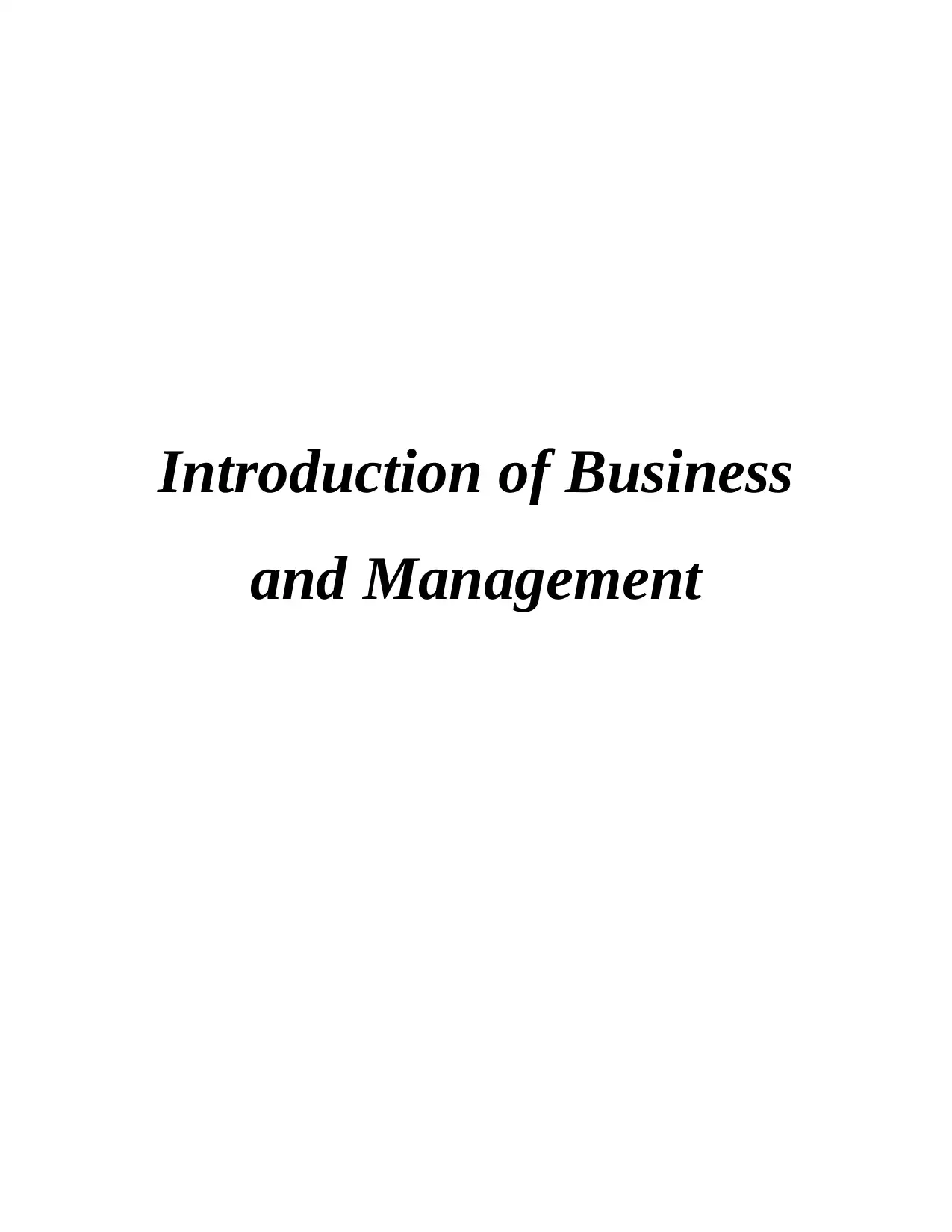
Introduction of Business
and Management
and Management
Paraphrase This Document
Need a fresh take? Get an instant paraphrase of this document with our AI Paraphraser
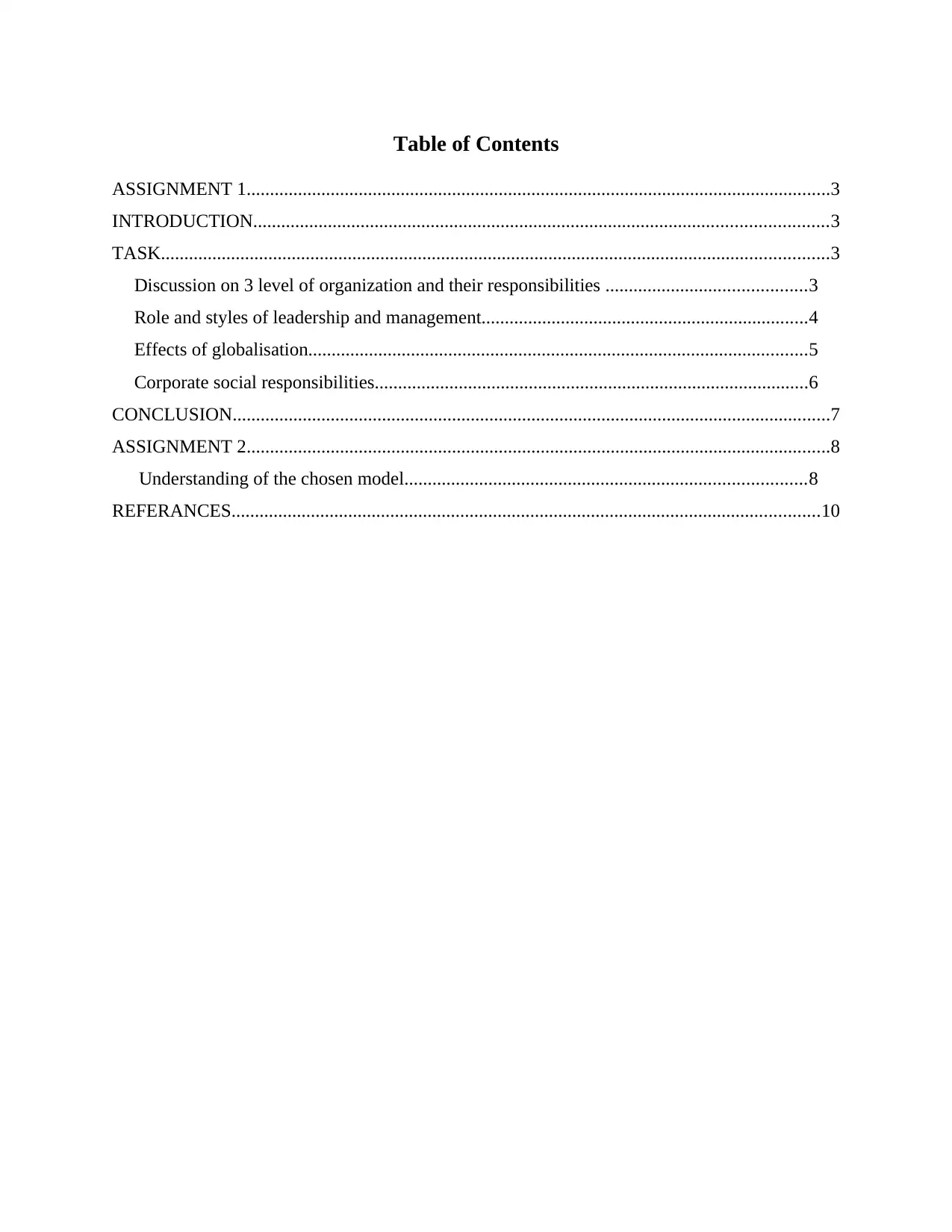
Table of Contents
ASSIGNMENT 1.............................................................................................................................3
INTRODUCTION...........................................................................................................................3
TASK...............................................................................................................................................3
Discussion on 3 level of organization and their responsibilities ...........................................3
Role and styles of leadership and management......................................................................4
Effects of globalisation...........................................................................................................5
Corporate social responsibilities.............................................................................................6
CONCLUSION................................................................................................................................7
ASSIGNMENT 2.............................................................................................................................8
Understanding of the chosen model......................................................................................8
REFERANCES..............................................................................................................................10
ASSIGNMENT 1.............................................................................................................................3
INTRODUCTION...........................................................................................................................3
TASK...............................................................................................................................................3
Discussion on 3 level of organization and their responsibilities ...........................................3
Role and styles of leadership and management......................................................................4
Effects of globalisation...........................................................................................................5
Corporate social responsibilities.............................................................................................6
CONCLUSION................................................................................................................................7
ASSIGNMENT 2.............................................................................................................................8
Understanding of the chosen model......................................................................................8
REFERANCES..............................................................................................................................10

ASSIGNMENT 1
INTRODUCTION
Business management is the outline of the main business function and define different
industry. It can be explain what is business and what business do in the management. A business
is process of uses resources to define the need of customers and provide goods and services
according to the customers demand. It define costumers need as well as demand. When the
consumers purchase the goods to personal use which is income of the business and the output
define by the providing service to customers and satisfy their need and demand. Basically the
aim of the business to making a profit in high level to chive their goals and objectives. Business
management is define the purpose of organization and provide specific knowledge in markets,
customers,finance and set the policy and strategies to manage and implement their strategies to
get profitability in the business. In the below mentioned assignment, discussion of 3 level of
organization.
TASK
Discussion on 3 level of organization and their responsibilities
The level of management define the chain of command in organization also determine the
authority, status and managerial position (Brandimarte, 2012). The three level of management
can be define in organization they are as follows:
Top level management:- In the top level management board of directors, chief executive
or managing director. The top level management is also known as administration level that
include authority of resources and manage goal and objective by the directors. They must be
evaluate the planning of organization and prepare policy, strategy as well plan for the business.
The top level management convey information to the middle level management and give order in
lay down. They can control and coordinate whole activities of all the department and provide
right direction and guideline to their subordinate (Jeston and Nelis, 2014). The top level
INTRODUCTION
Business management is the outline of the main business function and define different
industry. It can be explain what is business and what business do in the management. A business
is process of uses resources to define the need of customers and provide goods and services
according to the customers demand. It define costumers need as well as demand. When the
consumers purchase the goods to personal use which is income of the business and the output
define by the providing service to customers and satisfy their need and demand. Basically the
aim of the business to making a profit in high level to chive their goals and objectives. Business
management is define the purpose of organization and provide specific knowledge in markets,
customers,finance and set the policy and strategies to manage and implement their strategies to
get profitability in the business. In the below mentioned assignment, discussion of 3 level of
organization.
TASK
Discussion on 3 level of organization and their responsibilities
The level of management define the chain of command in organization also determine the
authority, status and managerial position (Brandimarte, 2012). The three level of management
can be define in organization they are as follows:
Top level management:- In the top level management board of directors, chief executive
or managing director. The top level management is also known as administration level that
include authority of resources and manage goal and objective by the directors. They must be
evaluate the planning of organization and prepare policy, strategy as well plan for the business.
The top level management convey information to the middle level management and give order in
lay down. They can control and coordinate whole activities of all the department and provide
right direction and guideline to their subordinate (Jeston and Nelis, 2014). The top level
⊘ This is a preview!⊘
Do you want full access?
Subscribe today to unlock all pages.

Trusted by 1+ million students worldwide
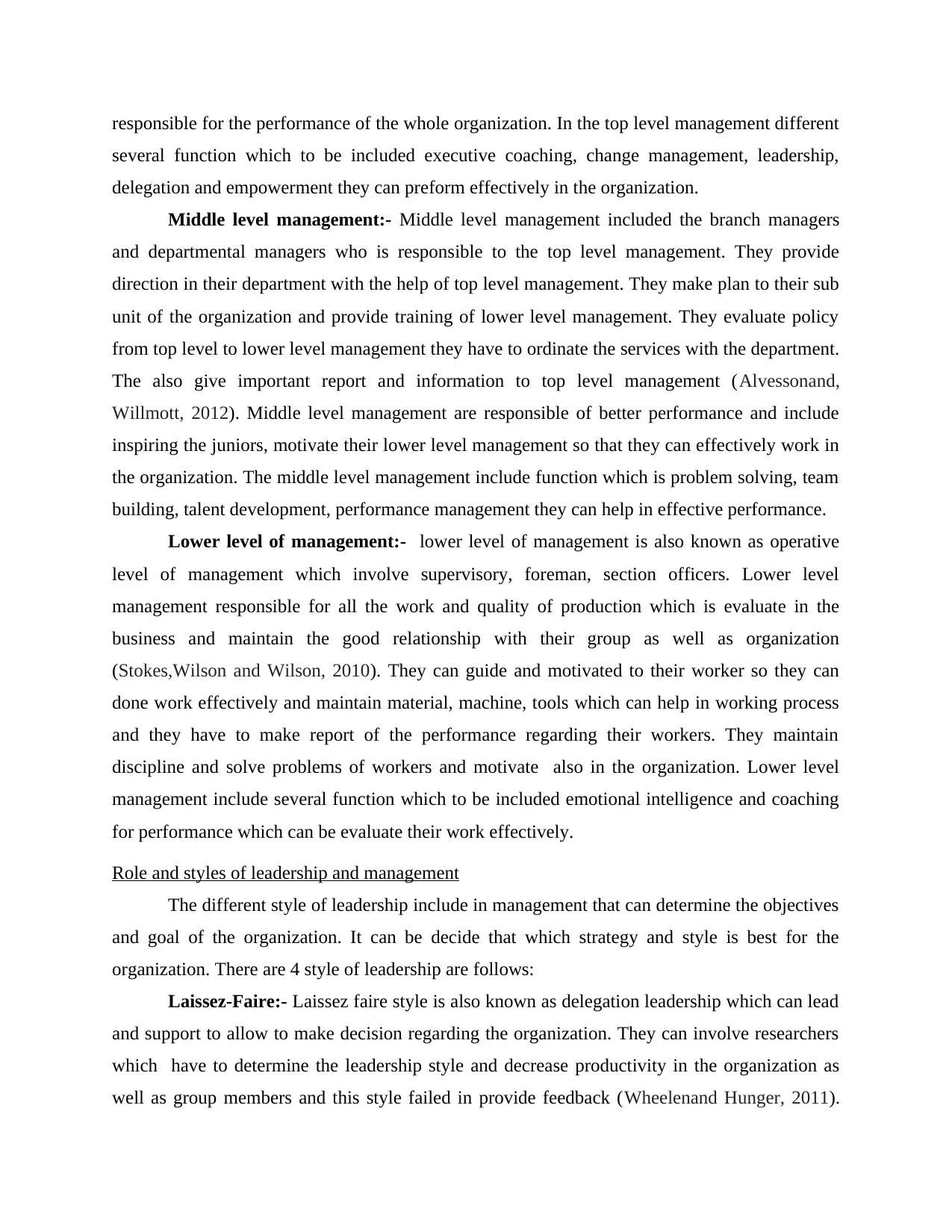
responsible for the performance of the whole organization. In the top level management different
several function which to be included executive coaching, change management, leadership,
delegation and empowerment they can preform effectively in the organization.
Middle level management:- Middle level management included the branch managers
and departmental managers who is responsible to the top level management. They provide
direction in their department with the help of top level management. They make plan to their sub
unit of the organization and provide training of lower level management. They evaluate policy
from top level to lower level management they have to ordinate the services with the department.
The also give important report and information to top level management (Alvessonand,
Willmott, 2012). Middle level management are responsible of better performance and include
inspiring the juniors, motivate their lower level management so that they can effectively work in
the organization. The middle level management include function which is problem solving, team
building, talent development, performance management they can help in effective performance.
Lower level of management:- lower level of management is also known as operative
level of management which involve supervisory, foreman, section officers. Lower level
management responsible for all the work and quality of production which is evaluate in the
business and maintain the good relationship with their group as well as organization
(Stokes,Wilson and Wilson, 2010). They can guide and motivated to their worker so they can
done work effectively and maintain material, machine, tools which can help in working process
and they have to make report of the performance regarding their workers. They maintain
discipline and solve problems of workers and motivate also in the organization. Lower level
management include several function which to be included emotional intelligence and coaching
for performance which can be evaluate their work effectively.
Role and styles of leadership and management
The different style of leadership include in management that can determine the objectives
and goal of the organization. It can be decide that which strategy and style is best for the
organization. There are 4 style of leadership are follows:
Laissez-Faire:- Laissez faire style is also known as delegation leadership which can lead
and support to allow to make decision regarding the organization. They can involve researchers
which have to determine the leadership style and decrease productivity in the organization as
well as group members and this style failed in provide feedback (Wheelenand Hunger, 2011).
several function which to be included executive coaching, change management, leadership,
delegation and empowerment they can preform effectively in the organization.
Middle level management:- Middle level management included the branch managers
and departmental managers who is responsible to the top level management. They provide
direction in their department with the help of top level management. They make plan to their sub
unit of the organization and provide training of lower level management. They evaluate policy
from top level to lower level management they have to ordinate the services with the department.
The also give important report and information to top level management (Alvessonand,
Willmott, 2012). Middle level management are responsible of better performance and include
inspiring the juniors, motivate their lower level management so that they can effectively work in
the organization. The middle level management include function which is problem solving, team
building, talent development, performance management they can help in effective performance.
Lower level of management:- lower level of management is also known as operative
level of management which involve supervisory, foreman, section officers. Lower level
management responsible for all the work and quality of production which is evaluate in the
business and maintain the good relationship with their group as well as organization
(Stokes,Wilson and Wilson, 2010). They can guide and motivated to their worker so they can
done work effectively and maintain material, machine, tools which can help in working process
and they have to make report of the performance regarding their workers. They maintain
discipline and solve problems of workers and motivate also in the organization. Lower level
management include several function which to be included emotional intelligence and coaching
for performance which can be evaluate their work effectively.
Role and styles of leadership and management
The different style of leadership include in management that can determine the objectives
and goal of the organization. It can be decide that which strategy and style is best for the
organization. There are 4 style of leadership are follows:
Laissez-Faire:- Laissez faire style is also known as delegation leadership which can lead
and support to allow to make decision regarding the organization. They can involve researchers
which have to determine the leadership style and decrease productivity in the organization as
well as group members and this style failed in provide feedback (Wheelenand Hunger, 2011).
Paraphrase This Document
Need a fresh take? Get an instant paraphrase of this document with our AI Paraphraser

Laissez-faire style include poor production and lack of control in their supervision so that they
increase cost of the product. This style is manufacture no leadership for manager which is
generate negative impact in the organization, and lack of direction is also negative part of this
style.
Autocratic style:- In the leadership management this style have to allow to take as well
as make decision to the manager of the organization. The manager have to authority to develop
their organization with the help of employees and they make decision without the input of otters.
They include goal which is achieve by the organization they can maintain proper discipline and
full control of the team as well as team members (Armstrong and Taylor, 2014). The autocratic
style make whole strategic decision for lower lever employees.
Participative style:- Participative style is also known as democratic leadership it can be
involve of the team member and take decision by the participative leader. Democratic leadership
can be enhance the employee morale regarding the decision making of the organization.
Employees must be give contribute in the organization to define their goals and objective and
enhance their learning skills. In this leadership style all employees participating to make decision
making process and this style encourage employees to exchange their ideas in the entity. It have
to communicate with people to take decision about the unity plan (ZottAmit and Massa, 2011).
This style is adopted by CEO of NIKE which provide the support in attaining targets.
Transactional style:- Transactional style involve task that is perform by the employee.
In this style, manager of the organization provide the reward and incentives to the employees and
staff members according to their performance in the company. In this style manager and
organization have to attain goals and objectives which are predetermined by the higher
authorities of the business entity. These targets are to be evaluated by the employees which assist
in providing the direction and leadership of the manager to achieve those goals (Trkman, 2010).
Effects of globalisation
Globalisation is enhance competition in the organization its relates to the product and
service price, target market, technological adaption, quick response by the organization.
Globalisation process is increase productivity in market because any customers have many
choice regarding the goods and service and they want to in quickly and efficient way to fulfil
their needs. It can help in raising the standard of living every person and maintain
competitiveness. Globalization has to be created and enhance foreign trade in the world and it
increase cost of the product. This style is manufacture no leadership for manager which is
generate negative impact in the organization, and lack of direction is also negative part of this
style.
Autocratic style:- In the leadership management this style have to allow to take as well
as make decision to the manager of the organization. The manager have to authority to develop
their organization with the help of employees and they make decision without the input of otters.
They include goal which is achieve by the organization they can maintain proper discipline and
full control of the team as well as team members (Armstrong and Taylor, 2014). The autocratic
style make whole strategic decision for lower lever employees.
Participative style:- Participative style is also known as democratic leadership it can be
involve of the team member and take decision by the participative leader. Democratic leadership
can be enhance the employee morale regarding the decision making of the organization.
Employees must be give contribute in the organization to define their goals and objective and
enhance their learning skills. In this leadership style all employees participating to make decision
making process and this style encourage employees to exchange their ideas in the entity. It have
to communicate with people to take decision about the unity plan (ZottAmit and Massa, 2011).
This style is adopted by CEO of NIKE which provide the support in attaining targets.
Transactional style:- Transactional style involve task that is perform by the employee.
In this style, manager of the organization provide the reward and incentives to the employees and
staff members according to their performance in the company. In this style manager and
organization have to attain goals and objectives which are predetermined by the higher
authorities of the business entity. These targets are to be evaluated by the employees which assist
in providing the direction and leadership of the manager to achieve those goals (Trkman, 2010).
Effects of globalisation
Globalisation is enhance competition in the organization its relates to the product and
service price, target market, technological adaption, quick response by the organization.
Globalisation process is increase productivity in market because any customers have many
choice regarding the goods and service and they want to in quickly and efficient way to fulfil
their needs. It can help in raising the standard of living every person and maintain
competitiveness. Globalization has to be created and enhance foreign trade in the world and it
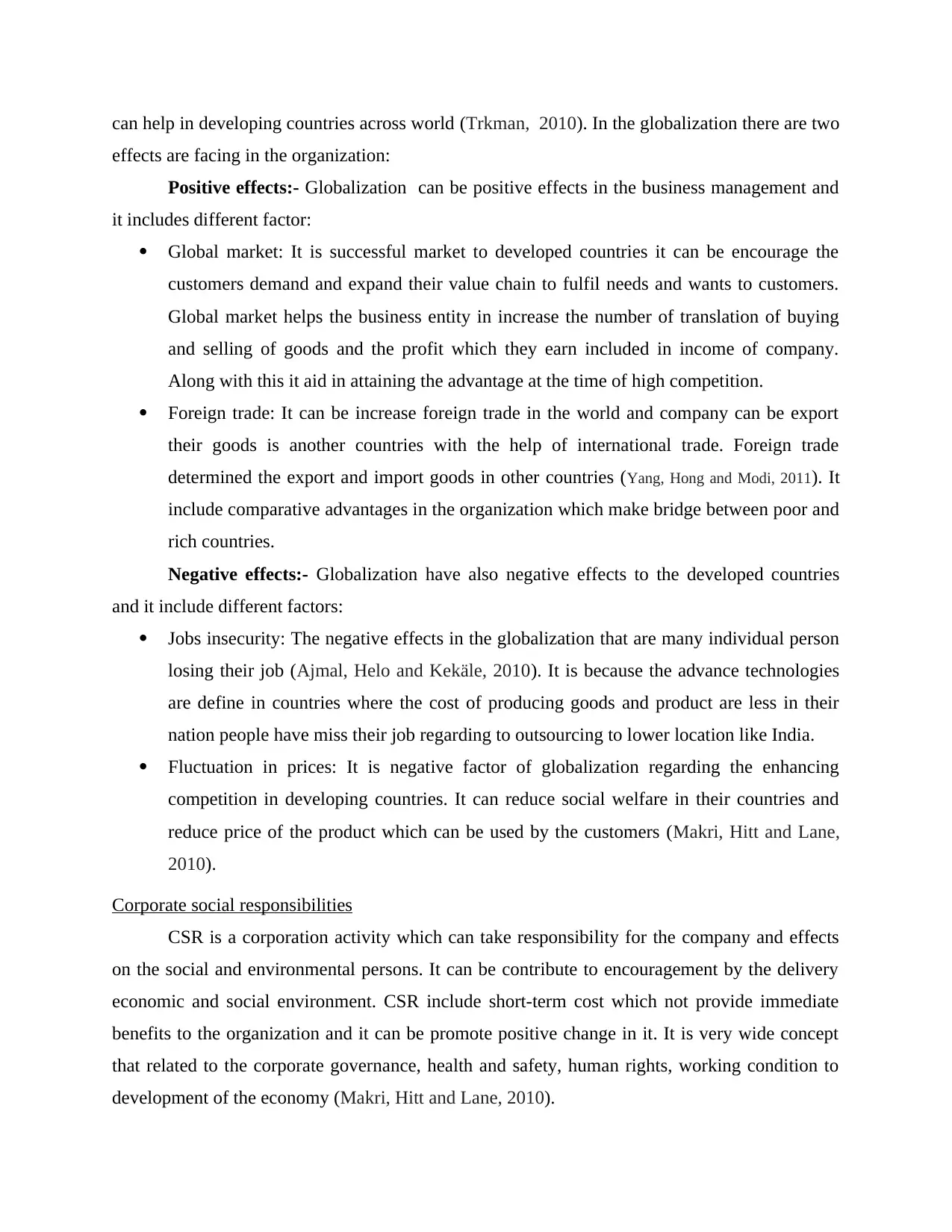
can help in developing countries across world (Trkman, 2010). In the globalization there are two
effects are facing in the organization:
Positive effects:- Globalization can be positive effects in the business management and
it includes different factor:
Global market: It is successful market to developed countries it can be encourage the
customers demand and expand their value chain to fulfil needs and wants to customers.
Global market helps the business entity in increase the number of translation of buying
and selling of goods and the profit which they earn included in income of company.
Along with this it aid in attaining the advantage at the time of high competition.
Foreign trade: It can be increase foreign trade in the world and company can be export
their goods is another countries with the help of international trade. Foreign trade
determined the export and import goods in other countries (Yang, Hong and Modi, 2011). It
include comparative advantages in the organization which make bridge between poor and
rich countries.
Negative effects:- Globalization have also negative effects to the developed countries
and it include different factors:
Jobs insecurity: The negative effects in the globalization that are many individual person
losing their job (Ajmal, Helo and Kekäle, 2010). It is because the advance technologies
are define in countries where the cost of producing goods and product are less in their
nation people have miss their job regarding to outsourcing to lower location like India.
Fluctuation in prices: It is negative factor of globalization regarding the enhancing
competition in developing countries. It can reduce social welfare in their countries and
reduce price of the product which can be used by the customers (Makri, Hitt and Lane,
2010).
Corporate social responsibilities
CSR is a corporation activity which can take responsibility for the company and effects
on the social and environmental persons. It can be contribute to encouragement by the delivery
economic and social environment. CSR include short-term cost which not provide immediate
benefits to the organization and it can be promote positive change in it. It is very wide concept
that related to the corporate governance, health and safety, human rights, working condition to
development of the economy (Makri, Hitt and Lane, 2010).
effects are facing in the organization:
Positive effects:- Globalization can be positive effects in the business management and
it includes different factor:
Global market: It is successful market to developed countries it can be encourage the
customers demand and expand their value chain to fulfil needs and wants to customers.
Global market helps the business entity in increase the number of translation of buying
and selling of goods and the profit which they earn included in income of company.
Along with this it aid in attaining the advantage at the time of high competition.
Foreign trade: It can be increase foreign trade in the world and company can be export
their goods is another countries with the help of international trade. Foreign trade
determined the export and import goods in other countries (Yang, Hong and Modi, 2011). It
include comparative advantages in the organization which make bridge between poor and
rich countries.
Negative effects:- Globalization have also negative effects to the developed countries
and it include different factors:
Jobs insecurity: The negative effects in the globalization that are many individual person
losing their job (Ajmal, Helo and Kekäle, 2010). It is because the advance technologies
are define in countries where the cost of producing goods and product are less in their
nation people have miss their job regarding to outsourcing to lower location like India.
Fluctuation in prices: It is negative factor of globalization regarding the enhancing
competition in developing countries. It can reduce social welfare in their countries and
reduce price of the product which can be used by the customers (Makri, Hitt and Lane,
2010).
Corporate social responsibilities
CSR is a corporation activity which can take responsibility for the company and effects
on the social and environmental persons. It can be contribute to encouragement by the delivery
economic and social environment. CSR include short-term cost which not provide immediate
benefits to the organization and it can be promote positive change in it. It is very wide concept
that related to the corporate governance, health and safety, human rights, working condition to
development of the economy (Makri, Hitt and Lane, 2010).
⊘ This is a preview!⊘
Do you want full access?
Subscribe today to unlock all pages.

Trusted by 1+ million students worldwide
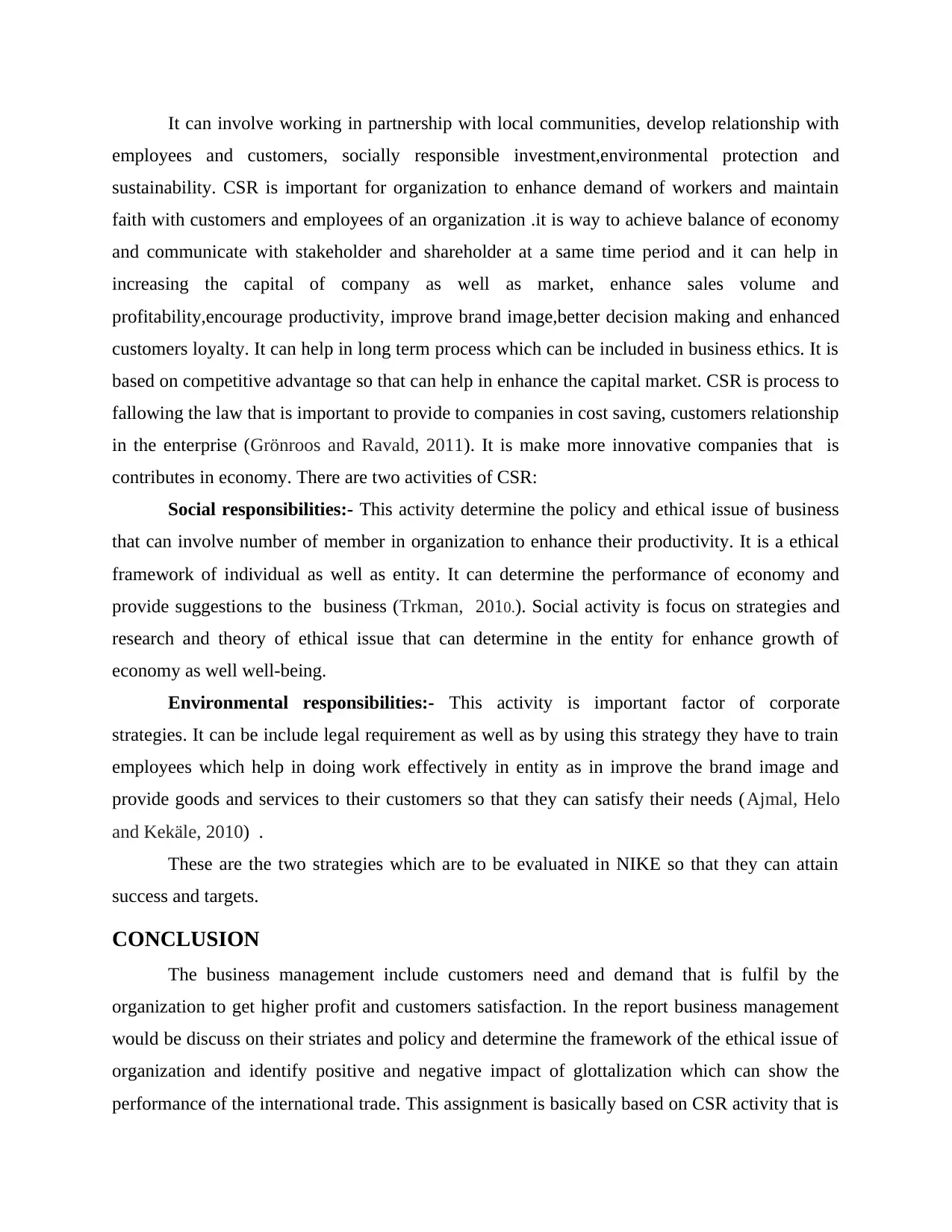
It can involve working in partnership with local communities, develop relationship with
employees and customers, socially responsible investment,environmental protection and
sustainability. CSR is important for organization to enhance demand of workers and maintain
faith with customers and employees of an organization .it is way to achieve balance of economy
and communicate with stakeholder and shareholder at a same time period and it can help in
increasing the capital of company as well as market, enhance sales volume and
profitability,encourage productivity, improve brand image,better decision making and enhanced
customers loyalty. It can help in long term process which can be included in business ethics. It is
based on competitive advantage so that can help in enhance the capital market. CSR is process to
fallowing the law that is important to provide to companies in cost saving, customers relationship
in the enterprise (Grönroos and Ravald, 2011). It is make more innovative companies that is
contributes in economy. There are two activities of CSR:
Social responsibilities:- This activity determine the policy and ethical issue of business
that can involve number of member in organization to enhance their productivity. It is a ethical
framework of individual as well as entity. It can determine the performance of economy and
provide suggestions to the business (Trkman, 2010.). Social activity is focus on strategies and
research and theory of ethical issue that can determine in the entity for enhance growth of
economy as well well-being.
Environmental responsibilities:- This activity is important factor of corporate
strategies. It can be include legal requirement as well as by using this strategy they have to train
employees which help in doing work effectively in entity as in improve the brand image and
provide goods and services to their customers so that they can satisfy their needs (Ajmal, Helo
and Kekäle, 2010) .
These are the two strategies which are to be evaluated in NIKE so that they can attain
success and targets.
CONCLUSION
The business management include customers need and demand that is fulfil by the
organization to get higher profit and customers satisfaction. In the report business management
would be discuss on their striates and policy and determine the framework of the ethical issue of
organization and identify positive and negative impact of glottalization which can show the
performance of the international trade. This assignment is basically based on CSR activity that is
employees and customers, socially responsible investment,environmental protection and
sustainability. CSR is important for organization to enhance demand of workers and maintain
faith with customers and employees of an organization .it is way to achieve balance of economy
and communicate with stakeholder and shareholder at a same time period and it can help in
increasing the capital of company as well as market, enhance sales volume and
profitability,encourage productivity, improve brand image,better decision making and enhanced
customers loyalty. It can help in long term process which can be included in business ethics. It is
based on competitive advantage so that can help in enhance the capital market. CSR is process to
fallowing the law that is important to provide to companies in cost saving, customers relationship
in the enterprise (Grönroos and Ravald, 2011). It is make more innovative companies that is
contributes in economy. There are two activities of CSR:
Social responsibilities:- This activity determine the policy and ethical issue of business
that can involve number of member in organization to enhance their productivity. It is a ethical
framework of individual as well as entity. It can determine the performance of economy and
provide suggestions to the business (Trkman, 2010.). Social activity is focus on strategies and
research and theory of ethical issue that can determine in the entity for enhance growth of
economy as well well-being.
Environmental responsibilities:- This activity is important factor of corporate
strategies. It can be include legal requirement as well as by using this strategy they have to train
employees which help in doing work effectively in entity as in improve the brand image and
provide goods and services to their customers so that they can satisfy their needs (Ajmal, Helo
and Kekäle, 2010) .
These are the two strategies which are to be evaluated in NIKE so that they can attain
success and targets.
CONCLUSION
The business management include customers need and demand that is fulfil by the
organization to get higher profit and customers satisfaction. In the report business management
would be discuss on their striates and policy and determine the framework of the ethical issue of
organization and identify positive and negative impact of glottalization which can show the
performance of the international trade. This assignment is basically based on CSR activity that is
Paraphrase This Document
Need a fresh take? Get an instant paraphrase of this document with our AI Paraphraser

included by the entity to define in the wide process that is include social and environmental
responsibilities. It is included roles and style of leadership and management and the best style of
leadership which is follow by the NIKE that is democratic style which is show the make
decision regarding the organization to enhance the productivity as well as profitability. Company
can follow autocratic style which is help in encourage the performance in the market to enhance
their productivity.
Globalisation is determined the worldwide study to increase knowledge and government
investment. Is is focus on status of internationalization and helps in increasing the economic
growth. It is determined the foundation of modern concept which is influencing institution and
public sector. Ethical is a explanation of what is right and what is wrong for the organization that
is affected by the situation. The ethical investment is large nature of process which is reflected
by the public opinion. The CSR helps in organisation, public relation, and standard of living of
individual person.
ASSIGNMENT 2
Understanding of the chosen model.
Trait model/approach: trait model of leadership says that “Leaders ore born not made”.
This model says that there are some necessary traits which should be there in a person to become
a successful leader. This theory is not applicable in today's world. This model reveals that the
qualities which are necessary to become a successful leader can be in a person by birth or that
qualities can not teach to a person (Alvessonand, Willmott, 2012). Self
confidence,passion,patience,innovation,inspiration, transparency and many more traits are
necessary to become a successful leader and this theory says that these qualities can be in a
person by birth and can not be taught to a person. In today's business environment this model is
not applicable but there are still some people who believes that is truth.
Application of model
When it comes about organisation then every enterprise needs a leader who has different
types of traits to control the different situation s of the enterprise at the same time contributes in
achieving organisation's goals and objectives(Trkman, 2010). Today business environment is
very complex only that person can manage the activities of organisation as a leader who has
some specific traits to deals with the day to day operations of the business. Every enterprise
responsibilities. It is included roles and style of leadership and management and the best style of
leadership which is follow by the NIKE that is democratic style which is show the make
decision regarding the organization to enhance the productivity as well as profitability. Company
can follow autocratic style which is help in encourage the performance in the market to enhance
their productivity.
Globalisation is determined the worldwide study to increase knowledge and government
investment. Is is focus on status of internationalization and helps in increasing the economic
growth. It is determined the foundation of modern concept which is influencing institution and
public sector. Ethical is a explanation of what is right and what is wrong for the organization that
is affected by the situation. The ethical investment is large nature of process which is reflected
by the public opinion. The CSR helps in organisation, public relation, and standard of living of
individual person.
ASSIGNMENT 2
Understanding of the chosen model.
Trait model/approach: trait model of leadership says that “Leaders ore born not made”.
This model says that there are some necessary traits which should be there in a person to become
a successful leader. This theory is not applicable in today's world. This model reveals that the
qualities which are necessary to become a successful leader can be in a person by birth or that
qualities can not teach to a person (Alvessonand, Willmott, 2012). Self
confidence,passion,patience,innovation,inspiration, transparency and many more traits are
necessary to become a successful leader and this theory says that these qualities can be in a
person by birth and can not be taught to a person. In today's business environment this model is
not applicable but there are still some people who believes that is truth.
Application of model
When it comes about organisation then every enterprise needs a leader who has different
types of traits to control the different situation s of the enterprise at the same time contributes in
achieving organisation's goals and objectives(Trkman, 2010). Today business environment is
very complex only that person can manage the activities of organisation as a leader who has
some specific traits to deals with the day to day operations of the business. Every enterprise
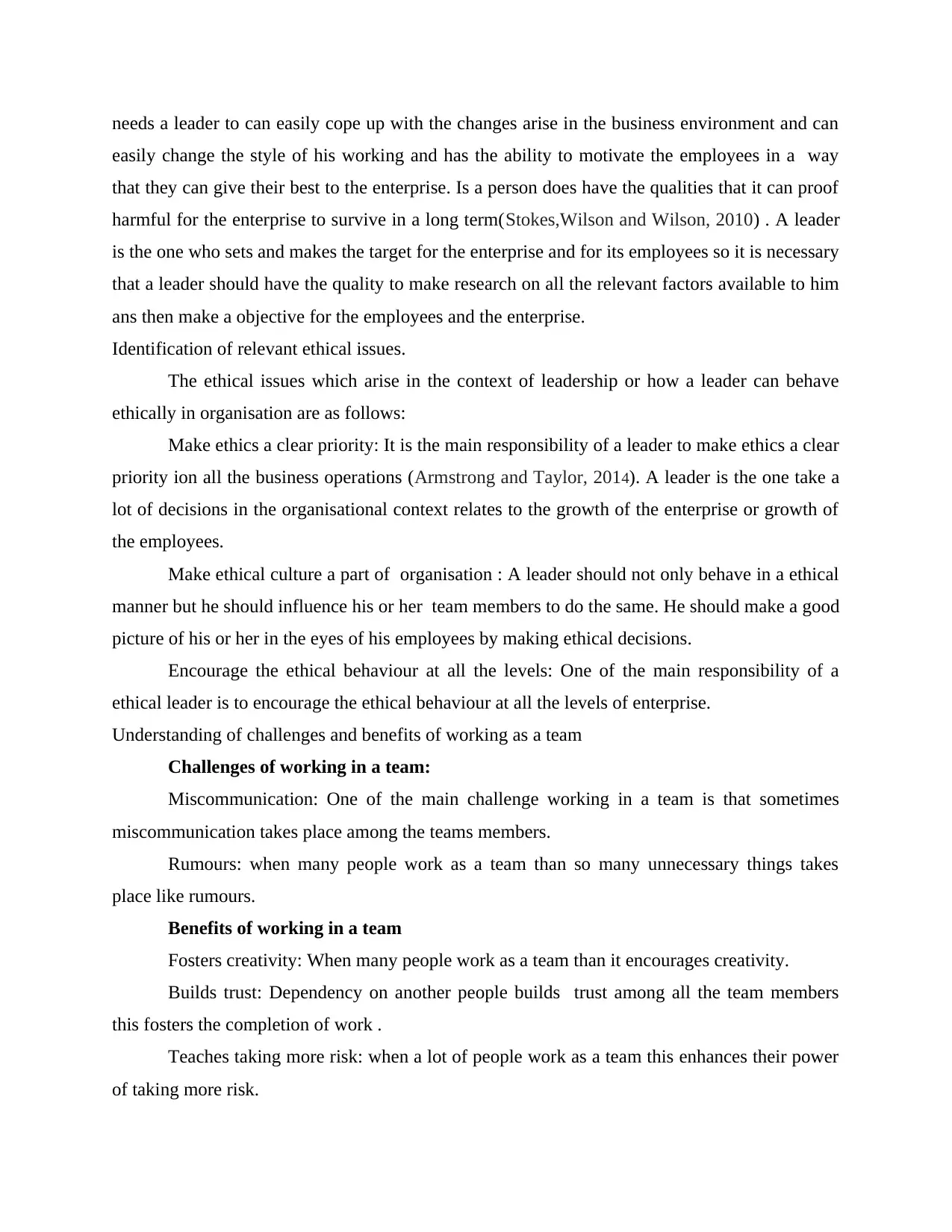
needs a leader to can easily cope up with the changes arise in the business environment and can
easily change the style of his working and has the ability to motivate the employees in a way
that they can give their best to the enterprise. Is a person does have the qualities that it can proof
harmful for the enterprise to survive in a long term(Stokes,Wilson and Wilson, 2010) . A leader
is the one who sets and makes the target for the enterprise and for its employees so it is necessary
that a leader should have the quality to make research on all the relevant factors available to him
ans then make a objective for the employees and the enterprise.
Identification of relevant ethical issues.
The ethical issues which arise in the context of leadership or how a leader can behave
ethically in organisation are as follows:
Make ethics a clear priority: It is the main responsibility of a leader to make ethics a clear
priority ion all the business operations (Armstrong and Taylor, 2014). A leader is the one take a
lot of decisions in the organisational context relates to the growth of the enterprise or growth of
the employees.
Make ethical culture a part of organisation : A leader should not only behave in a ethical
manner but he should influence his or her team members to do the same. He should make a good
picture of his or her in the eyes of his employees by making ethical decisions.
Encourage the ethical behaviour at all the levels: One of the main responsibility of a
ethical leader is to encourage the ethical behaviour at all the levels of enterprise.
Understanding of challenges and benefits of working as a team
Challenges of working in a team:
Miscommunication: One of the main challenge working in a team is that sometimes
miscommunication takes place among the teams members.
Rumours: when many people work as a team than so many unnecessary things takes
place like rumours.
Benefits of working in a team
Fosters creativity: When many people work as a team than it encourages creativity.
Builds trust: Dependency on another people builds trust among all the team members
this fosters the completion of work .
Teaches taking more risk: when a lot of people work as a team this enhances their power
of taking more risk.
easily change the style of his working and has the ability to motivate the employees in a way
that they can give their best to the enterprise. Is a person does have the qualities that it can proof
harmful for the enterprise to survive in a long term(Stokes,Wilson and Wilson, 2010) . A leader
is the one who sets and makes the target for the enterprise and for its employees so it is necessary
that a leader should have the quality to make research on all the relevant factors available to him
ans then make a objective for the employees and the enterprise.
Identification of relevant ethical issues.
The ethical issues which arise in the context of leadership or how a leader can behave
ethically in organisation are as follows:
Make ethics a clear priority: It is the main responsibility of a leader to make ethics a clear
priority ion all the business operations (Armstrong and Taylor, 2014). A leader is the one take a
lot of decisions in the organisational context relates to the growth of the enterprise or growth of
the employees.
Make ethical culture a part of organisation : A leader should not only behave in a ethical
manner but he should influence his or her team members to do the same. He should make a good
picture of his or her in the eyes of his employees by making ethical decisions.
Encourage the ethical behaviour at all the levels: One of the main responsibility of a
ethical leader is to encourage the ethical behaviour at all the levels of enterprise.
Understanding of challenges and benefits of working as a team
Challenges of working in a team:
Miscommunication: One of the main challenge working in a team is that sometimes
miscommunication takes place among the teams members.
Rumours: when many people work as a team than so many unnecessary things takes
place like rumours.
Benefits of working in a team
Fosters creativity: When many people work as a team than it encourages creativity.
Builds trust: Dependency on another people builds trust among all the team members
this fosters the completion of work .
Teaches taking more risk: when a lot of people work as a team this enhances their power
of taking more risk.
⊘ This is a preview!⊘
Do you want full access?
Subscribe today to unlock all pages.

Trusted by 1+ million students worldwide
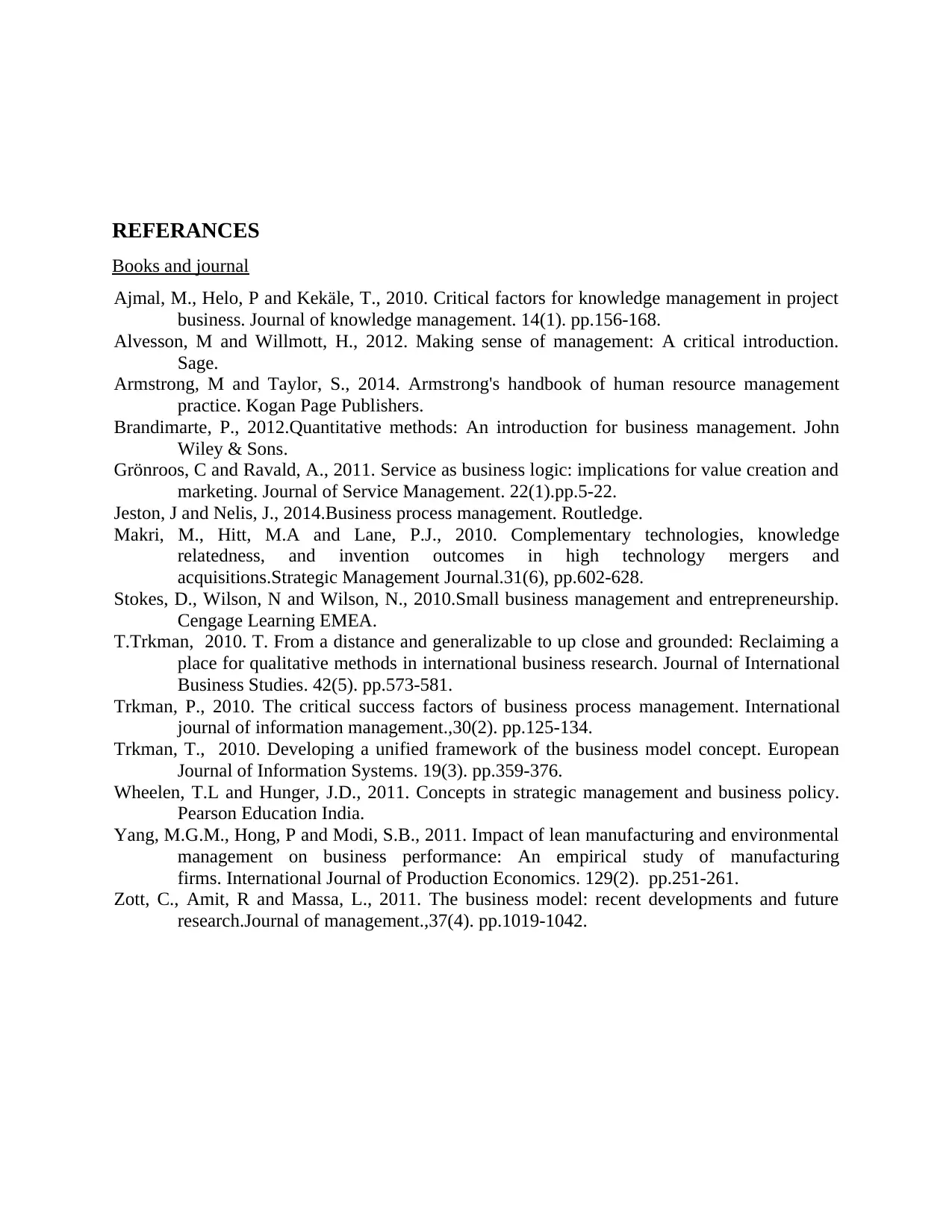
REFERANCES
Books and journal
Ajmal, M., Helo, P and Kekäle, T., 2010. Critical factors for knowledge management in project
business. Journal of knowledge management. 14(1). pp.156-168.
Alvesson, M and Willmott, H., 2012. Making sense of management: A critical introduction.
Sage.
Armstrong, M and Taylor, S., 2014. Armstrong's handbook of human resource management
practice. Kogan Page Publishers.
Brandimarte, P., 2012.Quantitative methods: An introduction for business management. John
Wiley & Sons.
Grönroos, C and Ravald, A., 2011. Service as business logic: implications for value creation and
marketing. Journal of Service Management. 22(1).pp.5-22.
Jeston, J and Nelis, J., 2014.Business process management. Routledge.
Makri, M., Hitt, M.A and Lane, P.J., 2010. Complementary technologies, knowledge
relatedness, and invention outcomes in high technology mergers and
acquisitions.Strategic Management Journal.31(6), pp.602-628.
Stokes, D., Wilson, N and Wilson, N., 2010.Small business management and entrepreneurship.
Cengage Learning EMEA.
T.Trkman, 2010. T. From a distance and generalizable to up close and grounded: Reclaiming a
place for qualitative methods in international business research. Journal of International
Business Studies. 42(5). pp.573-581.
Trkman, P., 2010. The critical success factors of business process management. International
journal of information management.,30(2). pp.125-134.
Trkman, T., 2010. Developing a unified framework of the business model concept. European
Journal of Information Systems. 19(3). pp.359-376.
Wheelen, T.L and Hunger, J.D., 2011. Concepts in strategic management and business policy.
Pearson Education India.
Yang, M.G.M., Hong, P and Modi, S.B., 2011. Impact of lean manufacturing and environmental
management on business performance: An empirical study of manufacturing
firms. International Journal of Production Economics. 129(2). pp.251-261.
Zott, C., Amit, R and Massa, L., 2011. The business model: recent developments and future
research.Journal of management.,37(4). pp.1019-1042.
Books and journal
Ajmal, M., Helo, P and Kekäle, T., 2010. Critical factors for knowledge management in project
business. Journal of knowledge management. 14(1). pp.156-168.
Alvesson, M and Willmott, H., 2012. Making sense of management: A critical introduction.
Sage.
Armstrong, M and Taylor, S., 2014. Armstrong's handbook of human resource management
practice. Kogan Page Publishers.
Brandimarte, P., 2012.Quantitative methods: An introduction for business management. John
Wiley & Sons.
Grönroos, C and Ravald, A., 2011. Service as business logic: implications for value creation and
marketing. Journal of Service Management. 22(1).pp.5-22.
Jeston, J and Nelis, J., 2014.Business process management. Routledge.
Makri, M., Hitt, M.A and Lane, P.J., 2010. Complementary technologies, knowledge
relatedness, and invention outcomes in high technology mergers and
acquisitions.Strategic Management Journal.31(6), pp.602-628.
Stokes, D., Wilson, N and Wilson, N., 2010.Small business management and entrepreneurship.
Cengage Learning EMEA.
T.Trkman, 2010. T. From a distance and generalizable to up close and grounded: Reclaiming a
place for qualitative methods in international business research. Journal of International
Business Studies. 42(5). pp.573-581.
Trkman, P., 2010. The critical success factors of business process management. International
journal of information management.,30(2). pp.125-134.
Trkman, T., 2010. Developing a unified framework of the business model concept. European
Journal of Information Systems. 19(3). pp.359-376.
Wheelen, T.L and Hunger, J.D., 2011. Concepts in strategic management and business policy.
Pearson Education India.
Yang, M.G.M., Hong, P and Modi, S.B., 2011. Impact of lean manufacturing and environmental
management on business performance: An empirical study of manufacturing
firms. International Journal of Production Economics. 129(2). pp.251-261.
Zott, C., Amit, R and Massa, L., 2011. The business model: recent developments and future
research.Journal of management.,37(4). pp.1019-1042.
1 out of 10
Related Documents
Your All-in-One AI-Powered Toolkit for Academic Success.
+13062052269
info@desklib.com
Available 24*7 on WhatsApp / Email
![[object Object]](/_next/static/media/star-bottom.7253800d.svg)
Unlock your academic potential
Copyright © 2020–2025 A2Z Services. All Rights Reserved. Developed and managed by ZUCOL.





